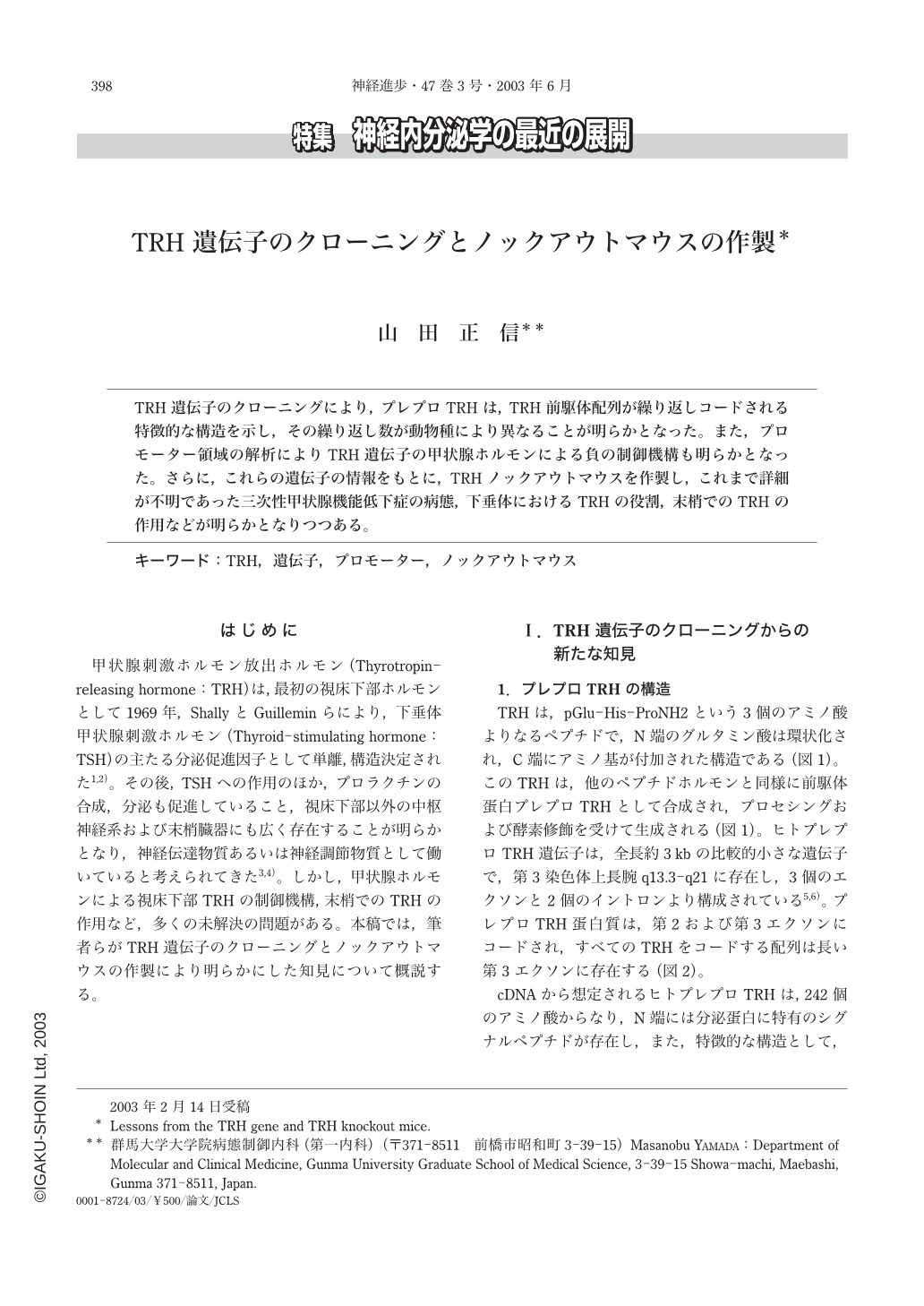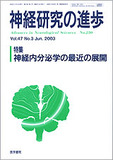Japanese
English
- 有料閲覧
- Abstract 文献概要
- 1ページ目 Look Inside
TRH遺伝子のクローニングにより,プレプロTRHは,TRH前駆体配列が繰り返しコードされる特徴的な構造を示し,その繰り返し数が動物種により異なることが明らかとなった。また,プロモーター領域の解析によりTRH遺伝子の甲状腺ホルモンによる負の制御機構も明らかとなった。さらに,これらの遺伝子の情報をもとに,TRHノックアウトマウスを作製し,これまで詳細が不明であった三次性甲状腺機能低下症の病態,下垂体におけるTRHの役割,末梢でのTRHの作用などが明らかとなりつつある。
はじめに
甲状腺刺激ホルモン放出ホルモン(Thyrotropin-releasing hormone:TRH)は,最初の視床下部ホルモンとして1969年,ShallyとGuilleminらにより,下垂体甲状腺刺激ホルモン(Thyroid-stimulating hormone:TSH)の主たる分泌促進因子として単離,構造決定された1,2)。その後,TSHへの作用のほか,プロラクチンの合成,分泌も促進していること,視床下部以外の中枢神経系および末梢臓器にも広く存在することが明らかとなり,神経伝達物質あるいは神経調節物質として働いていると考えられてきた3,4)。しかし,甲状腺ホルモンによる視床下部TRHの制御機構,末梢でのTRHの作用など,多くの未解決の問題がある。本稿では,筆者らがTRH遺伝子のクローニングとノックアウトマウスの作製により明らかにした知見について概説する。
Thyrotropin-releasing hormone(pGlu-His-ProNH2, TRH)is a hypothalamic hormone that stimulates thyrotropin(TSH)synthesis and secretion in the anterior pituitary and plays a critical role in the hypothalamus-pituitary-thyroid axis. TRH is also found in many organs including the extrahypothalamic central nervous, cardiovascular, reproductive systems, and gastrointestinal tract. However, the precise mechanism by which thyroid hormone regulates the TRH gene in hypothalamus and the role of TRH in peripheral organs remains unclear.
To investigate the molecular mechanism of thyroid hormone regulation of the TRH gene, we first cloned and characterized the human and mouse preproTRH genes. The gene is approximately 3.0 kb in length containing three exons and two introns. The human preproTRH has a characteristic structure containing 6 repetitive progenitor sequences, while the mouse has 5 copies. The transient transfection analysis revealed that the preproTRH gene is transcriptionally regulated by thyroid hormone, T3, and the thyroid hormone response element is located close to the transcription start site. A corepressor, NcoR, stimulates the basal promoter activity of the TRH gene.
To investigate the roles of TRH in the development and physiology of the pituitary thyrotrophs and in the peripheral organs, we next used homologous recombination to generate mice that lack TRH(TRH-/-). These TRH-/-mice were fertile, viable, and developed normally. There was no apparent abnormality in central nervous system, gastrointestinal tract, reproductive system as well as visual system. However,immunohistochemical analysis revealed a number of TSH-immunopositive cells in the TRH-/-pituitary on embryonic day 17.5 and at birth(postnatal day 0.5, P0.5), which were similar to those in the wild-type, indicating no requirement of embryonic TRH for the development of pituitary thyrotrophs. In contrast, apparent decreases in number and level of staining of TSH-immunopositive cells were observed after P10mutant pituitary. Similar decrease was observed in 8 weeks mutant pituitary. Consistent with these morphological results, TRH-/-mice showed normal thyroid hormone levels at birth, but the subsequent postnatal increase was depressed resulting in hypothyroidism. To evaluate the mechanism underlying this hypothyroidism, we measured TSH-βandαmRNA levels in the TRH-/-and wild-type pituitary. Despite hypothyroidism in the mutant mice, both the pituitary TSHβandαmRNA levels were paradoxically lower than those of the wild-type pituitary. These phenotypic changes were specific on the pituitary thyrotrophs but not on the other pituitary hormone producing cells.
These findings indicated that 1)TRH is essential only for the postnatal maintenance of the normal function of pituitary thyrotrophs, including the normal feedback regulation of the TSH gene by thyroid hormone, 2)embryonic TRH is not required for normal development of the fetal pituitary thyrotroph, and 3)as reflecting its name, TRH has more critical action especially on the pituitary thyrotrophs than on other pituitary hormone producing cells.

Copyright © 2003, Igaku-Shoin Ltd. All rights reserved.


